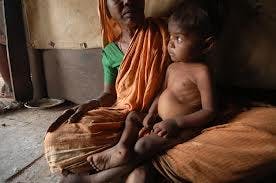India's malnutrition - A complex case of surplus food and hungry mouths
Jan 21, 2015
Story


Pappi, a 6-month old, lies listless and lifeless at her home in her village in Rajasthan. Her skin,pale and dry and her tongue shriveled. Looking at her frail and limp body, the tell-tale signs of malnutrition and prolonged starvation are too evident to ignore. In a country where more than 5000 children die each day due to malnutrition, it comes as a shocker when we hear that we have an excess of food grains and our buffer stocks are more than two and a half times the strategic reserve, that we need to maintain.
According to a recent report, we have about 667 lac tons of food grains as on January 1st, 2013, which is almost 250 percent more than what it was in 2008 and more than excess of buffer stocks than required.With such abundance, one is forced to wonder about our high malnutrition rates which is ranked among the highest in the world, with countries like Ethiopia and Bangladesh faring better than us?
What is worse is that malnutrition in India is not limited to nutritional intake alone, with girls being at a higher risk than boys, due to their lower social status and discriminatory practices. The report of the Ministry of Statistics and Program Implementation, urges us to look at the various facets of malnutrition and what causes it. Mother's health and her overall well being has being given top priority along with the educational qualification that she has. It is reported that malnutrition is higher among children whose mothers are uneducated or have less than five years of education. It also states that, when it comes to completing the vaccination/immunization cycle of the child, a mother's education plays an important role in this regard. Her awareness toward the health benefit schemes along with access to proper health services and hygienic practices, are crucial in deciding the health and longevity of the child.
But, with our faulty Public Distribution System (PDS) and rampant bureaucratic corruption, we cannot place the onus only on our mothers. This grave situation worsens further because of lack of warehouses to store the grains and the lack of proper storage facilities. Most of the times the food grains rot and the needy never receive even a single morsel of the grain.The creeping profiteering and negligence on part of the officials work in tandem to ensure that the food stock just keeps piling on, without ever reaching the hungry mouths of the poor children.
The solution to this complexity is not easy as commitment from both public and private fronts is needed to overcome it.Despite our rapid economic growth and innumerable schemes later,our situation of malnutrition remains dire. We have failed as a nation to provide basic nutritional facilities to our children.
The Integrated Childhood Development Service ( ICDS ), launched in 1975 by our Government, boasted of being the world's biggest early-childhood scheme. But both ICDS and midday meal scheme failed due to the rampant inefficiency and incoherent planning. Insufficient funds coupled with lackadaisical attitude of our Netas ( ministers) only made sure that their promises remained rhetoric and never materialized into something.
As a nation, it is high time we placed equal importance to human development rather than concentrating only on the economic front. We need to shift our focus to our mothers and children,before the spiraling cycle of malnutrition kills more leaving the mouths hungry and dry.




